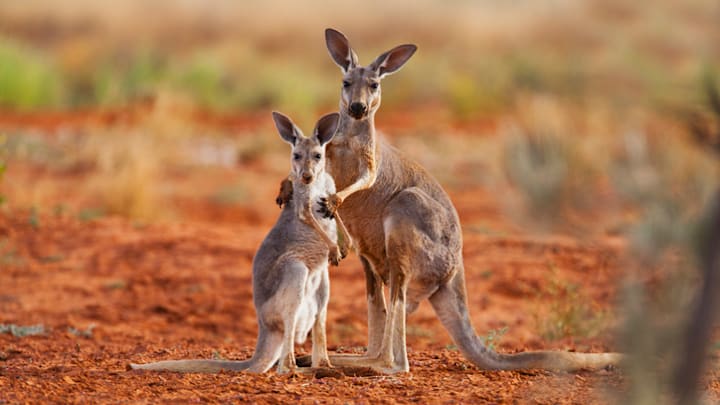Are wallabies just travel-sized kangaroos? Not exactly. They are part of the same family and they share a few physical traits, but there are plenty of differences between these two Australian animals.
Max Height | Habitat | Diet | |
|---|---|---|---|
Wallabies | 3 feet | Swamps, forests, deserts, rocky cliffs | Leaves |
Kangaroos | 6 feet | Grasslands | Grasses |
Are Wallabies Kangaroos?
Kangaroos and wallabies are both members of the family Macropodidae, but they don’t necessarily belong to the same genus, so wallabies are not simply mini-kangaroos.
Macropod is Latin for “big foot,” referring to the giant tootsies that let these animals make their famous leaps. Red kangaroos, the world’s largest marsupials, can travel up to 43 feet in one leap. That’s about three car lengths in a single bound. They can also crawl and swim. Both kangaroos and wallabies have powerful hind limbs that are much longer than their forelimbs, plus muscular tails that help them keep their balance.

Kangaroos and wallabies are marsupials, which give birth to ultra-tiny, undeveloped offspring called joeys, each roughly the size of a single AirPod. At birth, the joeys crawl up to mom’s belly pouch (a.k.a. her marsupium) where they will finish developing. In kangaroos and wallabies, this pouch opens to the front so the joey can face the same direction as mom.
Both animals are herbivores and eat plants but have different types of teeth. Wallabies’ teeth are flat to grind up leaves, while kangaroos have curved teeth to slice through the grasses on their menu.
Wallaby vs. Kangaroo Size
Kangaroos are the largest macropods, reaching up to 6 feet in height. In these animals, the distance between their knees and ankles is longer than it is in wallabies, making their legs look even longer than they are. Wallabies don’t grow taller than 3 feet (six if you include their tail) and are sometimes considerably tinier. The smallest species is the Parma wallaby of eastern Australia, which measures just 52.8 centimeters (21 inches) tall—about the size of an average house cat.
Wallabies’ smaller size gives them several advantages. They can occupy ecological niches like scrublands, swamps, forests, deserts, and rocky terrain while their larger relatives require wider open grasslands. Brush-tailed rock wallabies, for instance, can scurry up and down cliffs and hide from predators in the crags.

This specialization has resulted in more species of wallabies than kangaroos. There are roughly 30 species of wallaby and just six species of kangaroo, and three of these are considered “wallaroos”—macropods of a size between wallaby and ‘roo.
Wallabies’ coats tend to be thicker and sport more colors and patterns than those of kangaroos. Yellow-footed rock wallabies, for example, have tails resembling those of ring-tailed lemurs, and distinct slashes of black and white on their faces and bodies. Kangaroo coats tend to be more uniform in muted browns or grays, though the male red kangaroo has a rich rust-colored coat with white undersides.
Lifespans of Wallabies vs. Kangaroos
A big disadvantage to the wallabies’ diminutive sizes is that they have more predators than the larger kangaroos. Dingoes, Tasmanian devils, foxes, cats, dogs, and even wedge-tailed eagles prey upon the smaller macropods. Only dingoes, however, have the strength to take down a kangaroo. Perhaps as a result, wallabies have shorter average lifespans in the wild—nine years compared to 23 years for ‘roos.
